Overview
The article highlights nine essential JavaScript security best practices that developers should adopt to tackle the coding challenges they face. These practices, bolstered by statistics and expert insights, underscore the necessity of proactive measures. For instance:
- Implementing strong authentication
- Conducting regular security testing
- Keeping dependencies up-to-date
These are crucial steps to mitigate risks effectively. By following these guidelines, developers can significantly enhance their coding and safeguard user data against various vulnerabilities.
Introduction
In the dynamic realm of web development, security is a critical concern for developers facing numerous challenges. As cyberattacks evolve in sophistication, the necessity for effective security measures has never been more urgent. This article explores essential strategies for bolstering application security, including:
- The use of automated code optimization tools like Kodezi
- Secure coding practices
- Regular security testing
By examining key techniques such as:
- Establishing a Content Security Policy
- Validating user inputs
- Implementing multi-factor authentication
Developers can strengthen their defenses against vulnerabilities like Cross-Site Scripting and SQL injection. Furthermore, adopting a proactive approach to security clarifies the path to building resilient applications, empowering developers to protect user data and uphold trust in our interconnected digital landscape.
Kodezi | Professional OpenAPI Specification Generator - AI Dev-Tool: Streamline JavaScript Security with Automated Code Optimization
In today's fast-paced development environment, coding challenges are a common hurdle for many developers. Kodezi addresses these issues with a comprehensive set of tools designed to enhance JavaScript protection by implementing JavaScript security best practices through automated code optimization and debugging. By utilizing Kodezi's features, developers can effectively optimize their codebases, seamlessly incorporating JavaScript security best practices along with other safety and coding standards. Furthermore, the platform's automated debugging functionalities are crucial in detecting vulnerabilities in real-time. This enables prompt resolution of performance bottlenecks and safety concerns, ultimately improving code quality while following JavaScript security best practices. Wouldn't it be beneficial to lower the chances of breaches while enhancing your coding workflow? Kodezi stands out as an essential tool for contemporary programmers seeking to strengthen their protective measures.
A recent case study on Kodezi's automated code optimization revealed that programmers experienced a remarkable 40% decrease in vulnerabilities. This statistic showcases the effectiveness of these tools in practical applications, making Kodezi not just a tool, but a valuable partner in your development journey. Explore the tools available on Kodezi's platform today and elevate your coding practices.
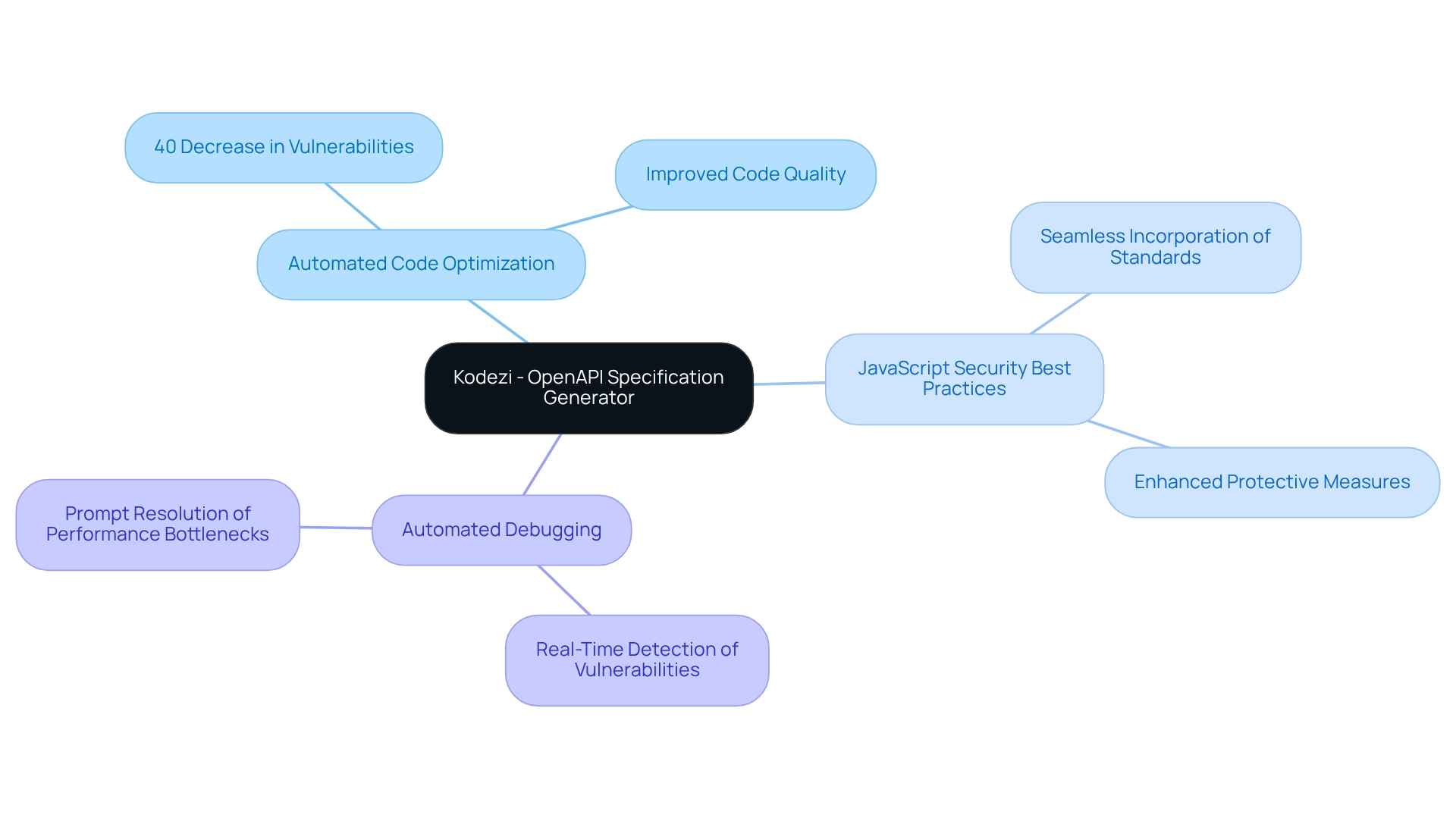
Implement Content Security Policy: Protect Your Application from Cross-Site Scripting Attacks
A Content Security Policy (CSP) is a vital security measure that mitigates the risk of Cross-Site Scripting (XSS) attacks by defining which dynamic resources are allowed to load. Establishing a CSP enables programmers to restrict the origins from which scripts, styles, and other resources can be executed, significantly reducing the likelihood of harmful code execution. To implement a CSP effectively, developers should specify their policy within the HTTP headers of their software, ensuring that only trusted sources are permitted.
Furthermore, regularly reviewing and updating the CSP is crucial to address emerging threats and vulnerabilities. Notably, the inclusion of 'unsafe-inline' in a CSP can undermine its effectiveness, as it permits inline JavaScript execution, potentially leading to vulnerabilities. Developers are strongly advised to avoid this directive unless absolutely necessary. As Akshay Khot, an independent software studio owner, emphasizes, 'A well-defined CSP is one of the javascript security best practices that is a critical component of modern web development.'
Statistics indicate that XSS remains one of the most prevalent web vulnerabilities, underscoring the importance of a robust CSP. In 2025, the adoption rates of CSP in web applications are expected to rise, reflecting a growing recognition of its effectiveness in preventing XSS attacks. Optimal methods for defining a CSP involve specifying trusted domains, using nonce or hash-based techniques for inline scripts, and frequently reviewing CSP violation reports to detect potential risks. The server managing CSP violation reports can store or process the incoming reports as required, which is crucial for addressing threats efficiently.
Applications that successfully implement CSP and adhere to javascript security best practices demonstrate a commitment to safety, showcasing how effective policies can protect against XSS vulnerabilities. Moreover, programmers should consider the X-Frame-Options header to avoid clickjacking attacks, further improving the defense stance of their software. Similarly, specialists highlight that a well-defined CSP is a crucial element of contemporary web development, ensuring that applications remain robust against emerging threats.

Defend Against Cross-Site Scripting: Validate and Sanitize User Inputs
To effectively defend against Cross-Site Scripting (XSS) attacks, programmers must prioritize JavaScript security best practices, including robust input validation and sanitization techniques. This process involves rigorously checking user inputs against expected formats and eliminating any potentially harmful characters or scripts. Utilizing established libraries, such as DOMPurify and sanitize-html, that offer built-in sanitization functions can significantly streamline this effort. A whitelist method, which allows only recognized safe inputs, further enhances protection by reducing the risk of harmful data entry.
Statistics reveal that XSS vulnerabilities have led to significant breaches, such as the 2019 incident involving Fortnite, which exposed the data of over 200 million users. As cybersecurity specialist Bright pointed out, "In 2019, an XSS vulnerability in the popular multiplayer game Fortnite went unnoticed by the creators, exposing the data of over 200 million users." Such incidents underscore the critical need for effective input validation. Regularly updating validation rules is essential to adapt to evolving threats, ensuring that security measures remain effective against new attack vectors.
Incorporating expert insights, it is clear that understanding and implementing these techniques is vital for maintaining user trust and safeguarding sensitive information. Alooba emphasizes, "Understanding how XSS is used can help organizations better protect themselves against potential threats." For instance, a case study involving a social media giant illustrates the severe consequences of API flaws leading to unauthorized access, resulting in a multi-billion dollar decrease in market value and a loss of user confidence. By embracing modern optimal methods for input validation and sanitization, programmers can greatly reduce the risks linked to XSS attacks and adhere to JavaScript security best practices.

Prevent Injection Attacks: Use Prepared Statements and Parameterized Queries
To effectively prevent injection attacks, developers must prioritize the use of prepared statements and parameterized queries when interacting with databases. This method ensures that user inputs are treated strictly as data, not executable code, significantly reducing the risk of SQL injection. By clearly separating SQL commands from user input, prepared statements create a formidable barrier against malicious data manipulation.
Statistics reveal that SQL injection remains a prevalent threat, with hackers attacking every three seconds. This highlights the urgency of implementing javascript security best practices for secure coding. In 2025, the adoption of prepared statements in online platforms is projected to rise, reflecting a growing awareness of their importance in securing database interactions.
Furthermore, developers should conduct regular reviews of their database queries to ensure that all interactions adhere to javascript security best practices. Successful executions of parameterized queries can be observed in numerous platforms, where they have effectively prevented potential SQL injection attempts. Expert opinions consistently affirm that prepared statements are among the most effective strategies for preventing SQL injection. As Venkatesh Sundar points out, "AppTrana WAAP aids in safeguarding against SQL injection assaults by examining the incoming traffic to your web platform and detecting harmful SQL code," highlighting their importance in contemporary web development.
In addition, the transition to remote work has resulted in a 238% rise in cyberattacks, underscoring the necessity for improved protective measures. By implementing these methods in accordance with javascript security best practices, developers can enhance the safety of their applications and safeguard sensitive information from misuse.

Secure Authentication: Implement Strong Password Policies and Multi-Factor Authentication
Implementing strong password policies is essential for secure authentication. Developers should enforce guidelines that mandate complex passwords, incorporating a mix of uppercase and lowercase letters, numbers, and special characters. This approach significantly reduces the risk of unauthorized access, as weak passwords are a common vulnerability.
Furthermore, multi-factor authentication (MFA) enhances protection by requiring users to present two or more verification factors to gain access. This can include:
- Something they know (like a password)
- Something they have (such as a mobile device)
- Something they are (biometric verification)
The adoption of MFA has been shown to dramatically decrease the likelihood of account breaches. Current statistics indicate that organizations implementing MFA experience up to a 99.9% reduction in account compromise.
In addition, regularly educating users about secure authentication practices is crucial. For instance, emphasizing the importance of unique passwords for different accounts can mitigate risks associated with password exposure. Incorporating biometric authentication as a second factor in the MFA process improves protection by ensuring that only authorized users can access accounts. A case study titled "Biometric Authentication as a 2FA Method" highlights how biometric methods, such as fingerprint scans or facial recognition, serve as a secure second factor in the MFA process, although it is important to note that no method is entirely foolproof against sophisticated attacks.
By 2025, the adoption rates of MFA in online platforms have increased, indicating a rising awareness of its significance in web protection. Developers should prioritize javascript security best practices to effectively safeguard their applications and protect user data. As Brad Jones, a product and technology specialist, stresses, "If you have additional inquiries, please contact your Snowflake account team," underscoring the importance of continuous communication regarding protective measures.
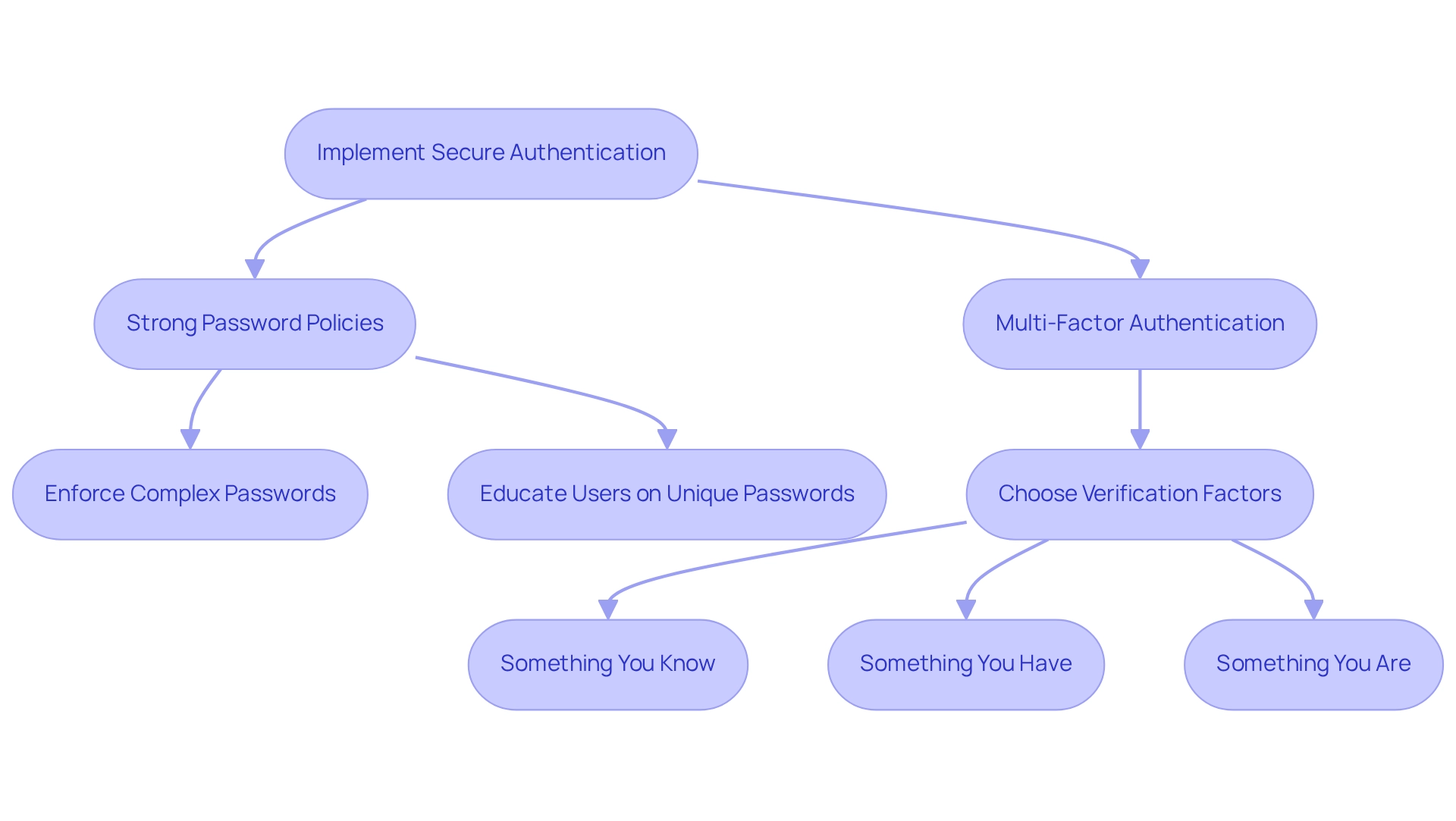
Avoid Security Misconfiguration: Regularly Review and Update Security Settings
Security misconfiguration poses significant risks, potentially leading to severe vulnerabilities if not managed effectively. Developers must prioritize regular reviews and updates of their protective configurations to ensure compliance with established JavaScript security best practices. Key actions include:
- Disabling unnecessary features
- Adhering to the principle of least privilege
- Modifying default settings to enhance [[[security
A recent report](https://sentinelone.com/cybersecurity-101/cloud-security/cloud-security-statistics)](https://sentinelone.com/cybersecurity-101/cloud-security/cloud-security-statistics](https://varonis.com/blog/cybersecurity-statistics)) indicates that a cybercrime incident is reported every six minutes. This statistic highlights the urgent need for proactive measures to safeguard applications. Performing regular assessments is crucial for detecting and correcting misconfigurations before they can be exploited by attackers. For instance, a disability support provider in Western Australia recently mitigated a network compromise by swiftly geo-blocking suspicious IP addresses and enforcing stricter access controls. This demonstrates the effectiveness of timely audits.
As mentioned by Sonrai Security, "It emphasizes the necessity for ongoing observation and assessment of cloud infrastructure to prevent, detect, and address vulnerabilities effectively." By adopting JavaScript security best practices, programmers can greatly minimize the chance of breaches and improve the overall reliability of their software. To take prompt action, developers should arrange an assessment within the next month to examine their current configurations and ensure they conform to optimal standards.
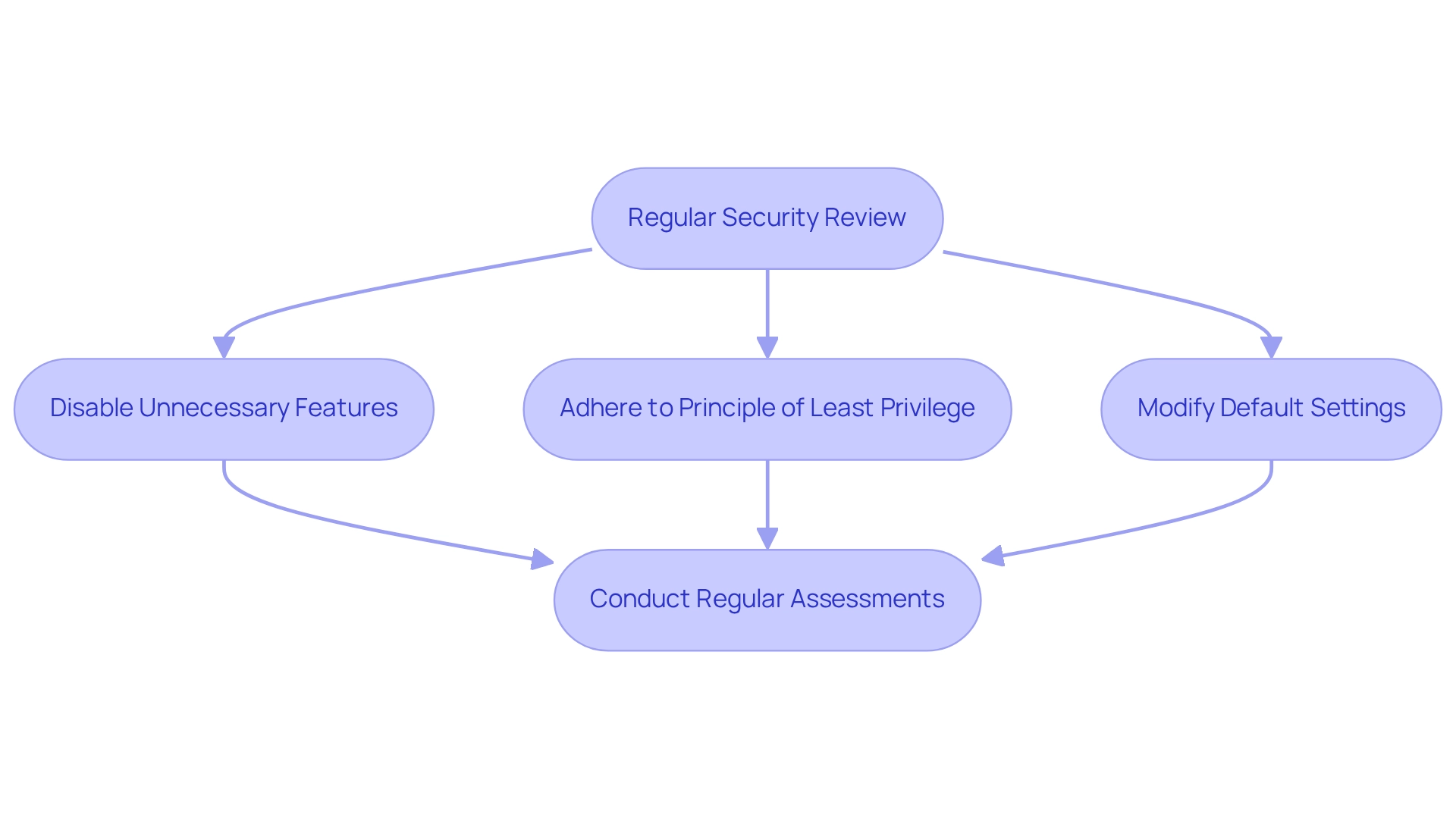
Adopt Secure Coding Practices: Follow the Principle of Least Privilege
Implementing javascript security best practices is vital for enhancing software security, particularly the principle of least privilege. This principle asserts that users and programs should only possess the minimum access necessary to fulfill their functions. By constraining permissions, programmers can markedly diminish the risk of unauthorized access and mitigate potential damage from compromised accounts. In 2025, it is projected that 45% of global organizations will face a supply chain attack, underscoring the urgency of adopting such measures. Furthermore, the principle of least privilege plays a crucial role in preventing these attacks by restricting access to sensitive data and functions.
To effectively implement least privilege access in applications, programmers should regularly assess user roles and permissions, ensuring they align with current operational needs. This proactive strategy not only improves safety but also promotes a culture of accountability within development teams. As IBM highlights, breaches involving stolen or compromised credentials take the longest to identify and contain, making it essential to limit user permissions to enhance security.
Incorporating tools like Kodezi can significantly aid in this process. With its automated code troubleshooting features, Kodezi assists developers in swiftly recognizing and resolving codebase problems, guaranteeing that safety guidelines are consistently adhered to. Specifically, Kodezi tackles performance bottlenecks, identifies vulnerabilities, and improves code formatting—all of which help uphold high coding standards.
The effect of following the principle of least privilege is considerable. Organizations that have embraced safe coding methods report a notable decrease in unauthorized access incidents. For example, Clio, a supplier of cloud-based legal software, has effectively incorporated this principle into its protection framework, resulting in increased profitability and enhanced client experiences by ensuring that only essential personnel have access to sensitive information.
Expert insights indicate that restricting user permissions is one of the most effective strategies for improving protection. As organizations navigate an increasingly complex threat landscape, prioritizing javascript security best practices, particularly the principle of least privilege in secure coding, will be essential for safeguarding sensitive data and maintaining trust with users. To further enhance safety, developers should carry out regular assessments of user roles and permissions, ensuring they are current and in accordance with the principle of least privilege while utilizing Kodezi's features for automated testing and compliance.
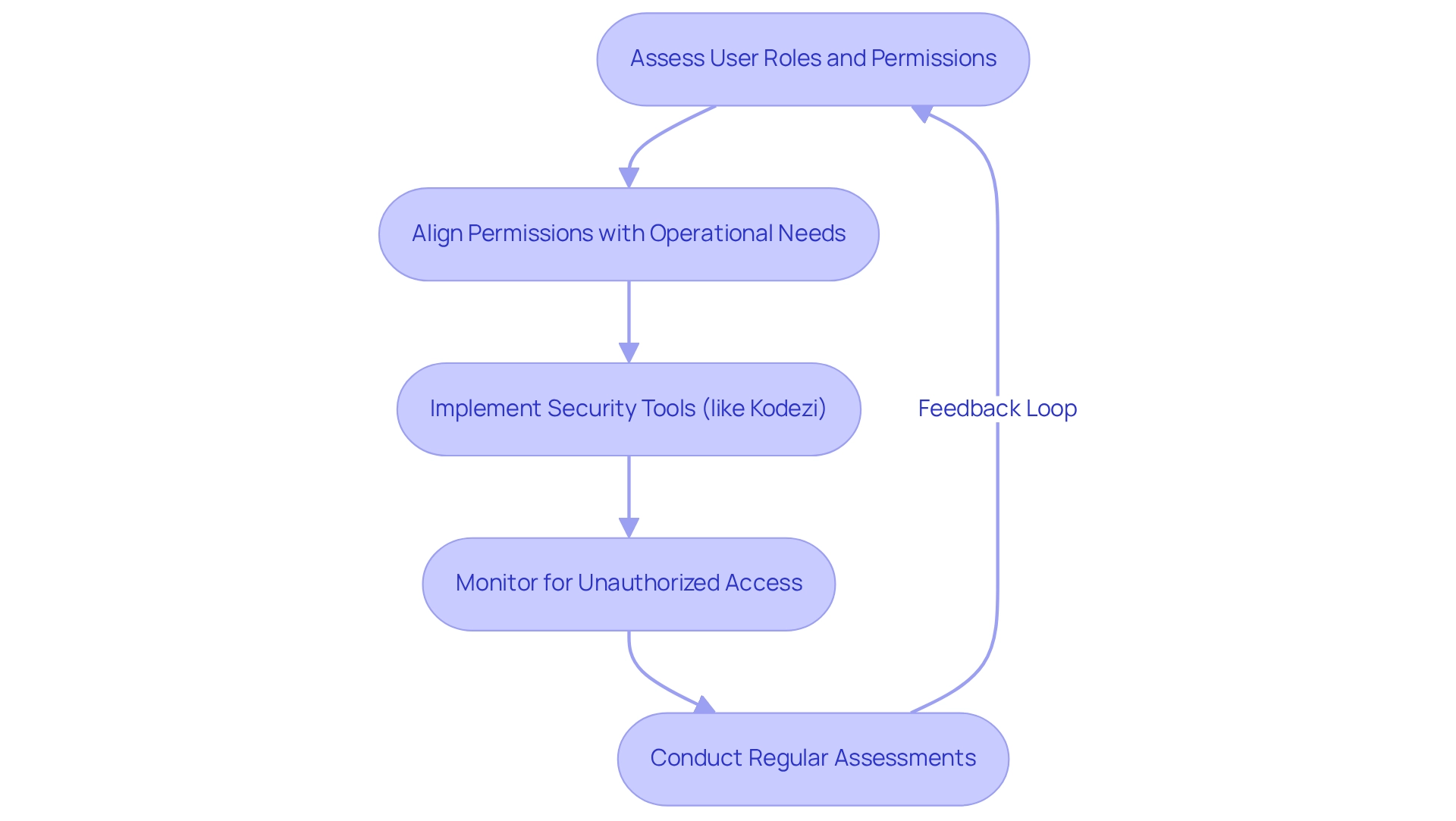
Conduct Regular Security Testing: Utilize Automated Tools for Vulnerability Scanning
Routine testing is crucial for safeguarding applications against potential threats, especially when implementing JavaScript security best practices. Have you considered how automated tools for vulnerability scanning can revolutionize your approach? These tools efficiently identify weaknesses within codebases, swiftly analyzing for known vulnerabilities and offering actionable insights for remediation.
By integrating vulnerability testing into the development lifecycle while following JavaScript security best practices, teams can ensure that issues are addressed promptly, significantly reducing the risk of exploitation in production environments. Furthermore, the effectiveness of automated vulnerability scanning tools lies in their ability to decrease the time needed to detect and resolve issues. Many organizations report a substantial enhancement in their protective stance.
Organizations implementing routine automated scanning methods have observed a reduction in successful phishing attacks, which is particularly significant as U.K. firms are among the most targeted by such assaults; furthermore, applying JavaScript security best practices not only enhances code quality but also fosters a culture of safety awareness within development teams.
Have you explored how Kodezi's automated code debugging function can help you? This feature enables developers to quickly detect and resolve codebase problems, ensuring adherence to the latest safety guidelines and coding standards. Ultimately, these methods lead to more robust systems and a stronger overall protective stance.
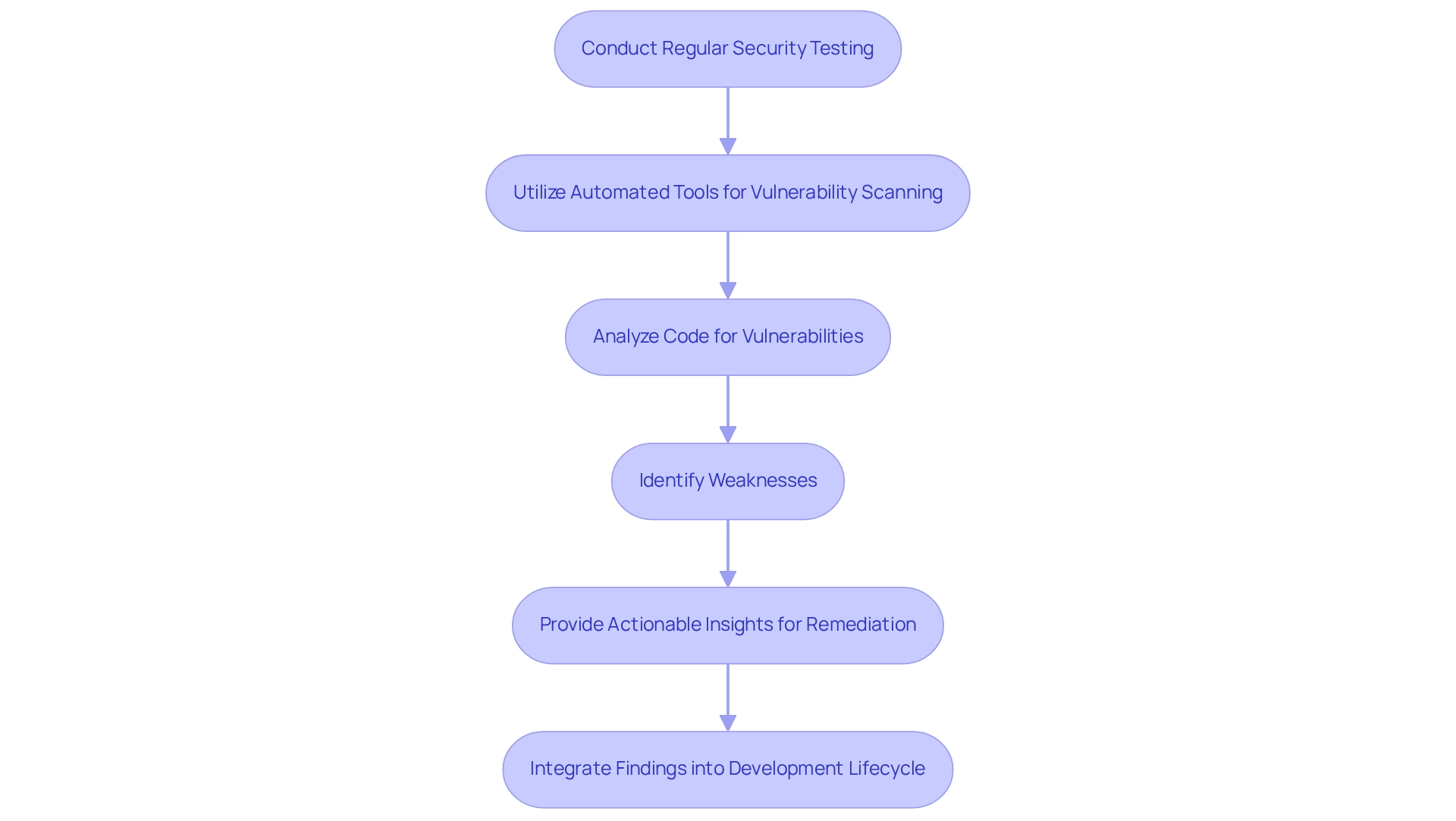
Update Dependencies: Regularly Check for Security Patches and Updates
Consistently refreshing dependencies is crucial for developers facing the ever-evolving challenges of software safety. Are you aware of the potential risks lurking in outdated libraries and frameworks? By overseeing these components for vulnerabilities and updates, developers can ensure they are utilizing the most recent versions available.
Tools like npm audit can be invaluable in identifying outdated packages and known vulnerabilities. Furthermore, by keeping dependencies current, developers can significantly mitigate risks associated with security flaws in third-party libraries, which is one of the JavaScript security best practices.
This proactive approach not only enhances the overall security of applications but also encourages the adoption of JavaScript security best practices and fosters a culture of continuous improvement in coding practices. Have you considered how prioritizing dependency management could impact your project's security and performance? By adopting these practices, you can improve your productivity and code quality in the long run.

Conclusion
In the ever-evolving landscape of web development, prioritizing security is paramount to safeguarding applications and user data. Developers face numerous coding challenges, particularly when it comes to protecting sensitive information. By implementing essential strategies such as automated code optimization with tools like Kodezi, they can significantly enhance their security posture. This proactive approach not only streamlines coding processes but also effectively identifies and remediates vulnerabilities in real-time.
Establishing a robust Content Security Policy (CSP), validating and sanitizing user inputs, and employing prepared statements are crucial techniques to defend against prevalent threats like Cross-Site Scripting and SQL injection. Furthermore, implementing strong password policies and multi-factor authentication fortifies secure authentication practices, reducing the likelihood of unauthorized access.
Regular security testing, updating dependencies, and adhering to the principle of least privilege further contribute to a resilient security framework. In addition, by routinely reviewing and updating security settings, developers can prevent misconfigurations that might lead to significant breaches.
Ultimately, the commitment to these security practices not only protects sensitive information but also fosters trust in the digital environment. As cyber threats become increasingly sophisticated, adopting a proactive and comprehensive approach to security is essential for developers dedicated to creating safe and reliable applications. Why not explore the tools available on Kodezi to enhance your coding practices today?
Frequently Asked Questions
What challenges do developers face in today's development environment?
Developers often encounter coding challenges that can hinder their progress in a fast-paced development environment.
How does Kodezi help developers with coding challenges?
Kodezi provides a comprehensive set of tools that enhance JavaScript protection by implementing security best practices through automated code optimization and debugging.
What benefits do developers gain from using Kodezi's features?
By utilizing Kodezi, developers can optimize their codebases, incorporate JavaScript security best practices, detect vulnerabilities in real-time, and resolve performance bottlenecks, ultimately improving code quality.
What does the case study on Kodezi's automated code optimization reveal?
The case study indicated that programmers experienced a 40% decrease in vulnerabilities when using Kodezi's automated code optimization tools.
What is a Content Security Policy (CSP)?
A Content Security Policy (CSP) is a security measure that helps mitigate the risk of Cross-Site Scripting (XSS) attacks by defining which dynamic resources are allowed to load in a web application.
How can developers implement a CSP effectively?
Developers can implement a CSP by specifying their policy within the HTTP headers of their software, restricting the origins from which scripts and resources can be executed.
Why is it important to regularly review and update a CSP?
Regularly reviewing and updating a CSP is crucial to address emerging threats and vulnerabilities, ensuring ongoing protection against XSS attacks.
What are some optimal methods for defining a CSP?
Optimal methods for defining a CSP include specifying trusted domains, using nonce or hash-based techniques for inline scripts, and frequently reviewing CSP violation reports.
What is the significance of input validation and sanitization in preventing XSS attacks?
Input validation and sanitization are vital for checking user inputs against expected formats and eliminating harmful characters or scripts, significantly reducing the risk of XSS vulnerabilities.
What are some tools that can assist with input sanitization?
Established libraries such as DOMPurify and sanitize-html offer built-in functions for input sanitization, helping to streamline the protection process.
What are the consequences of failing to implement effective input validation?
Failing to implement effective input validation can lead to significant breaches, as evidenced by incidents like the 2019 Fortnite data exposure, which affected over 200 million users.
How can organizations better protect themselves against XSS threats?
Organizations can enhance their protection against XSS threats by understanding how XSS is exploited and by regularly updating their input validation and sanitization measures.




